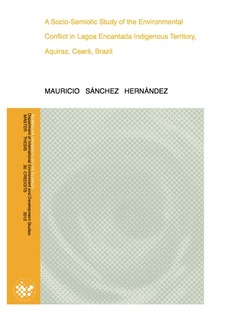| dc.contributor.author | Sánchez Hernández, Mauricio | |
| dc.date.accessioned | 2013-02-01T12:21:34Z | |
| dc.date.available | 2013-02-01T12:21:34Z | |
| dc.date.copyright | 2012 | |
| dc.date.issued | 2013-02-01 | |
| dc.identifier.uri | http://hdl.handle.net/11250/187806 | |
| dc.description.abstract | This study explores the semiotic dimensions of a conflict between a historical company in Ceará and a ‘recently-recognized’ indigenous community. It involves two discursive domains for networks of social practices. Firstly, it comprises the environmental-driven discussion going on between a ‘globalocentric’ style construed by the emblematic exporter of organic liquor, and the ‘subversive’ order of discourse articulated by the community, some academicians and NGO’s. This ‘subversive’ articulation exalts concepts such as ‘cultural autonomy’ and ‘environmental justice’ with the double purpose of denouncing the responsibility of Ypióca (the company) respecting the degradation of a rare inter-dune coastal lagoon inside Lagoa Encantada Indigenous Territory, and also demystifying the ‘preservation’ and ‘organic’ programmes conducted by the company within the land under dispute as its strategies to legitimize its industrial activities there. The ideological friction of this environmental discussion acquired international visibility when an article provoked the temporal suspension of the international organic seal held by Ypióca. This incident also provoked the open confrontation between the social groups involved through several judicial processes.
Secondly, the powerful exporter also construes and broadcasts a social and cultural depiction of the community where the legitimacy of its ethnic ascription and ‘special territorial rights’ are questioned and disregarded. Ypióca company interlinks a complex set of genres such as judicial processes, academic reports and cyber-politic contestations where its representatives are deeply skeptical about the ‘invention of traditions’ within the indigenous social practices. For its part, the community revolts against the stigmas and reconfigures them in emblems, which are incorporated into their ‘ethos’. Indigenous discourses inculcate their identity and style to other social groups through various semiotic modes including visual displays, suggestive lyrics, body language and the (re)creation of ‘ethnic’ symbols, such as rituals and sacred sites. Based on the dialectical-relational approach (Fairclough), this study explores how the discursive engagement within the strategies of social groups attempts to consolidate identities. In brief, the emergence, operationalization, and recontextualization of resonant discourses and suggestive styles are analyzed in order to demonstrate how, because of territorial interests, two social groups enact semiotic elements that contest for hegemony respecting the environmental and cultural representation of social reality in a locality surrounding the lagoon called the Lagoa Encantada. | no_NO |
| dc.language.iso | eng | no_NO |
| dc.publisher | Norwegian University of Life Sciences, Ås | |
| dc.subject | Environmental Politics | no_NO |
| dc.subject | Indigenous communities of Brazil | no_NO |
| dc.subject | Critical Discourse Analysis | no_NO |
| dc.subject | Socio-semiotic studies | no_NO |
| dc.title | A Socio-semiotic Study of the Environmental Conflict in Lagoa Encantada Indigenous Territory, Aquiraz, Ceará, Brazil | no_NO |
| dc.type | Master thesis | no_NO |
| dc.subject.nsi | VDP::Social science: 200::Social anthropology: 250 | no_NO |
| dc.subject.nsi | VDP::Social science: 200::Law: 340::Environmental law: 347 | no_NO |
| dc.source.pagenumber | 148 | no_NO |
